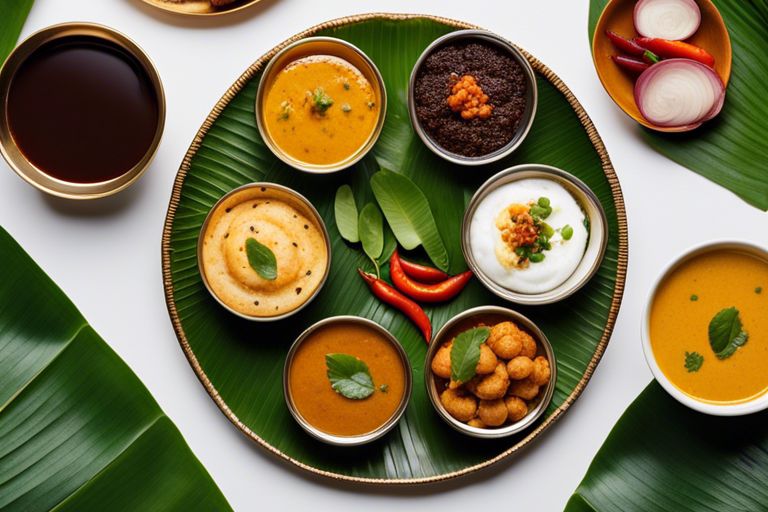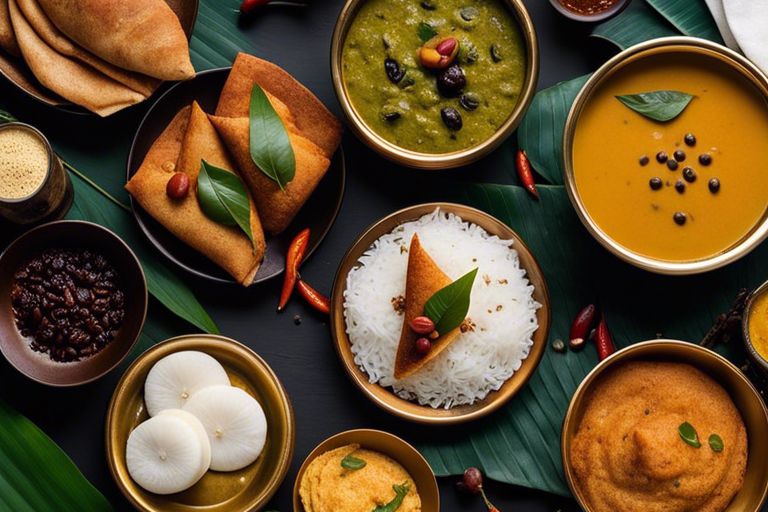#Spicy, diverse, and bursting with flavors – that’s how South Indian cuisine can be described. From the aromatic spices to the unique cooking techniques, South Indian food holds a special place in the world of culinary delights. The rich tradition and cultural influences have shaped a cuisine that is not only delicious but also stands out for its use of coconut, curry leaves, and tamarind. Let’s examine into what sets South Indian food apart from other regional cuisines and explore the reasons behind its popularity worldwide.
Key Takeaways:
- Use of aromatic spices: South Indian cuisine is known for its distinctive use of aromatic spices like curry leaves, mustard seeds, fenugreek, and asafoetida, which add layers of complex flavors to the dishes.
- Preference for rice: Rice is a staple in South Indian meals, and the variety of rice dishes like idli, dosa, and rice-based biryanis showcase the region’s deep-rooted connection with this grain.
- Diverse vegetarian options: South Indian cuisine offers a wide array of delicious and nutritious vegetarian dishes, with an emphasis on fresh vegetables, lentils, and coconut, making it a go-to choice for vegetarians and vegans.
The Unique Ingredients of South Indian Cuisine
Staple Ingredients and Their Nutritional Value
Your journey through South Indian cuisine is marked by the distinct use of staple ingredients that not only add flavor but also boast a range of nutritional benefits. Rice, lentils, coconut, and curry leaves are important elements in many South Indian dishes. Rice serves as the main component of most meals, providing an energy boost and important carbohydrates. Lentils, rich in protein and fiber, are a staple source of plant-based nutrients, aiding in digestion and overall health. Coconut, in various forms such as shredded, milk, or oil, adds a unique creaminess to dishes while offering a dose of healthy fats. Curry leaves not only enhance the taste but also provide vitamins A, B, C, and B2, important for skin and hair health.
Embracing these staple ingredients not only contributes to the distinctive flavors of South Indian cuisine but also provides a well-rounded nutritional profile. The combination of rice and lentils in dishes like dosas and idlis offers a complete protein source, important amino acids, and a low glycemic index. Incorporating coconut into curries and chutneys not only enhances the taste but also provides a source of medium-chain triglycerides, known for their potential health benefits. The inclusion of curry leaves in tempering adds not just aroma but also a punch of antioxidants and important nutrients, elevating the dish to a healthier level.
Regional Spices and Flavor Profiles
Ingredients are the heart of South Indian cuisine, with a diverse range of regional spices playing a pivotal role in creating the unique flavor profiles that set it apart. The distinct blend of spices such as mustard seeds, fenugreek, cumin, coriander, and turmeric forms the cornerstone of many dishes, offering a harmonious balance of heat, earthiness, and aroma. Each spice brings its own set of health benefits – from anti-inflammatory properties of turmeric to the digestive aid of cumin, making South Indian cuisine not only delicious but also beneficial for overall well-being.
Cooking Techniques and Food Preparation
There’s something truly special about South Indian cuisine that sets it apart from other regional foods in India. One of the key factors that contribute to this uniqueness is the cooking techniques and food preparation methods that are integral to South Indian culinary traditions. These methods have been passed down through generations, preserving the authentic flavors and aromas that make South Indian food so irresistible.
Traditional Methods of Fermentation and Steaming
Steaming and fermentation are two techniques that play a significant role in South Indian cooking. Idlis, a popular South Indian breakfast dish, are made by steaming a batter consisting of fermented rice and lentils. This process not only enhances the flavor of the dish but also makes it incredibly light and fluffy. Similarly, steamed rice cakes known as ‘puttu’ are a staple in South Indian cuisine, showcasing the expertise of using steam as a cooking method.
Another example of traditional food preparation in South India is the use of fermentation to make dosas. The batter made from fermented rice and lentils results in the characteristic tangy flavor and crispy texture that dosas are known for. This meticulous fermentation process is a testament to the patience and skill required in South Indian cooking.
The Role of Tadka in Flavor Enhancement
Enhancement of flavors is a crucial aspect of South Indian cooking, and ‘tadka’ plays a vital role in achieving this. Tadka, also known as tempering, involves adding spices like mustard seeds, curry leaves, and dried red chilies to hot oil or ghee. This technique not only adds depth and complexity to the dishes but also infuses them with aromatic flavors that are distinctly South Indian.
Traditional South Indian recipes often begin or end with a tadka, highlighting its importance in enhancing the overall taste of the dish. The sizzle of mustard seeds in hot oil releasing their nutty aroma is a sensory experience that sets South Indian cuisine apart from others.
Variety and Diversity of South Indian Dishes
South Indian cuisine is known for its incredible variety and diversity of dishes that cater to all taste preferences. From aromatic spices to unique flavors, every bite of a South Indian meal is a burst of culinary excitement.
Breakfast Specialties from South India
On any given morning in South India, you will find a plethora of breakfast options that are not only delicious but also nutritious. One of the most popular dishes is idli, steamed rice cakes served with savory lentil sambar and coconut chutney. Another favorite is dosa, a crispy crepe made from fermented rice and lentil batter, often filled with spiced potatoes.
South India is also famous for its vada, a savory fried snack made from lentil batter, and uttapam, a thick pancake topped with vegetables. These breakfast specialties are not only flavorful but also easy on the stomach, making them a perfect start to the day.
Signature Lunch and Dinner Delicacies
Lunch and dinner in South India are a grand affair, with a spread of dishes that showcase the region’s culinary prowess. From vegetable-packed sambar to tangy rasam, every meal is a celebration of flavors and textures that is not easy to forget.
One dish that stands out is the traditional South Indian thali, a platter filled with an assortment of dishes like rice, sambar, rasam, vegetable poriyal, and curd. The balance of flavors and the wholesome ingredients make this meal not just a feast for the taste buds but also a treat for the soul.
Cultural Significance and Health Benefits
Unlike other cuisines, South Indian food is deeply rooted in cultural traditions and offers a myriad of health benefits. The unique blend of flavors, use of fresh ingredients, and cooking techniques make it stand out as a wholesome and nourishing choice.
The Ayurvedic Connection in South Indian Food
Cultural practices play a significant role in shaping South Indian cuisine, especially when it comes to the principles of Ayurveda. Ayurveda, an ancient Indian system of medicine, emphasizes the balance of body and mind through the consumption of sattvic (pure), rajasic (active), and tamasic (heavy) foods. South Indian dishes are often prepared using fresh herbs, spices, and vegetables that are believed to have medicinal properties according to Ayurvedic principles, making them not just delicious but also beneficial for overall well-being.
Influenced by Ayurveda, South Indian cuisine incorporates ingredients like turmeric, curry leaves, coconut, and tamarind, known for their healing properties. The careful selection and combination of these ingredients in dishes such as sambar, rasam, and avial not only enhance the taste but also contribute to a well-balanced diet that supports digestion, immunity, and overall health.
Influence of Historical and Religious Practices on Cuisine
Religious beliefs and historical practices have also played a significant role in shaping South Indian food. The vegetarian diet prevalent in many South Indian communities can be attributed to cultural and religious factors, where vegetarianism is often associated with purity and spiritual well-being. This has led to the development of a rich variety of vegetarian dishes that are both flavorful and nutritious.
Any exploration of South Indian cuisine would be incomplete without acknowledging the influence of regional traditions and religious practices on the culinary landscape. Each dish carries with it a history and significance that goes beyond just the ingredients and flavors, reflecting a way of life that emphasizes harmony with nature and respect for the body and soul.

Final Words
Ultimately, the unique combination of flavors, spices, and cooking techniques is what makes South Indian food stand out from the rest. The emphasis on fresh ingredients, intricate preparations, and a wide variety of vegetarian and non-vegetarian options contributes to the richness and diversity of South Indian cuisine. Whether it’s the crispy dosas of Tamil Nadu, the spicy curries of Andhra Pradesh, or the coconut-infused dishes of Kerala, South Indian food offers a culinary experience that is unmatched. So, the next time you crave a flavorful and aromatic meal, consider exploring the vibrant and delicious world of South Indian cuisine.
FAQ
Q: What makes South Indian food unique compared to other regional cuisines in India?
A: South Indian food is known for its use of aromatic spices, coconut, tamarind, and curry leaves, which contribute to its distinctive flavors. It also features a wide variety of vegetarian dishes, such as dosas and idlis, that are not as commonly found in other Indian cuisines.
Q: How does South Indian cuisine differ from North Indian cuisine?
A: South Indian cuisine tends to be lighter and less rich than North Indian cuisine. It often incorporates more rice and lentils, while North Indian cuisine relies more heavily on breads like naan and roti, as well as cream-based curries. South Indian dishes are also typically spicier and use more coconut in their preparations.
Q: What are some signature dishes of South Indian cuisine that set it apart from other regional foods?
A: Some iconic South Indian dishes include dosas (thin, crispy rice pancakes), idlis (steamed rice cakes), vadas (savory fried lentil donuts), sambar (a tangy lentil stew), and rasam (a tamarind and tomato soup). These dishes showcase the unique flavors and diverse culinary traditions of South India.

